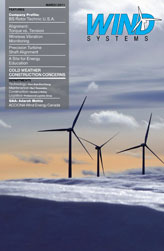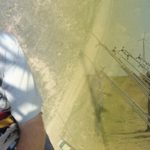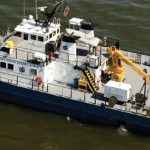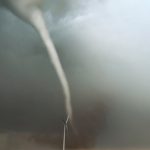Headquartered in Minneapolis, one of the coldest metropolitan areas in the United States, Mortenson Construction’s Renewable Energy Group has built nearly 100 utility-scale wind power projects in some of the most extreme climates throughout the United States and Canada. The successful building of wind power projects in the extreme cold requires careful preparation for equipment needs and special attention for the safety of those working in the field.
Equipment and Processes
Cold temperatures often bring snow, ice, and other conditions that warrant special equipment including personal protective equipment and clothing such as gloves, facemasks, and ice/snow traction devices that attach to heavy boots. Other requirements include enclosures for trailers, heaters, winter fuels mixed with anti-gelling additives, hot water pressure washers and anti-freezing biodegradable washer fluid for washing tower sections, concrete blankets and plastic tarps for concrete placing, and enclosures for tower grouting activates.
Snow and Ice Removal: In order to move forward safely with construction, snow and ice must be cleared from the project site to create a safe walking surface for the movement of equipment and workers. Construction can proceed during the winter and with some snow or ice on the project site. If there is an ice or snowstorm, however, construction may be halted until weather conditions improve. Once the storm has ended the contractor will remove the areas of snow accumulation before proceeding with construction. When the weather forecast predicts a snow or ice storm it is a good practice to lower the crane boom so any buildup of snow or ice can be removed. This is a must to ensure safe operation of the cranes. Construction team members will use rubber mallets to knock the snow or ice off the boom sections before the crane is placed into production operation.
Foundation Installation: Installing foundations in extreme cold temperatures requires additional equipment such as ground thaw and forced air heaters to make sure materials are within required temperature ranges during each step of the installation process. There are specific accommodations for mixing and placing the concrete. Portable concrete batch plants must be winterized sufficiently, which often means enclosing them in heavy plastic tarps or tents. The sand and aggregate must also be heated and mixed with hot water to correctly prepare the concrete.
Additionally, foundation rebar must be warmed to required temperature ranges before concrete can be placed around it. Under specific conditions the concrete must be secured under supplemental heat. Construction crews will use extra heaters and heavy insulated concrete blankets to ensure that the foundations are cured even in very cold temperatures. This type of planning also affects the placement of grout around the foundation pedestal.
Hazards and Concerns
Working in extremely cold temperatures can lead to dangerous conditions, the most significant of which are frostbite and hypothermia. Several factors contribute to the risk of injury including: temperature, wind speed, moisture (sweat or working near water), duration of exposure, clothing, work/rest schedule, work performed, and other individual characteristics.
Frostbite is the actual freezing of tissue. Exposed skin becomes vulnerable to frostbite when the air temperature drops below 0° C/32° F or when wind speeds are high creating a wind-chill effect. If skin is not protected, frostbite can lead to body tissue damage. Symptoms of frostbite vary from swelling and red coloration of the exposed area and slight pain in mild cases to extreme tissue damage with black/dark bluish-purple in severe cases. Depending on the level of exposure frostbite can occur with little or no pain or cause a burning/prickling sensation in more severe cases. If minor exposure has occurred the affected areas of the skin should be warmed slowly until normal temperatures are reached. When higher levels of exposure occur, medical attention should be initiated.
Hypothermia occurs when the body core temperature drops below 35° C/95° F. Once this happens the body loses its ability to prevent heat loss and is losing heat more quickly than it can create heat. Hypothermia is typically a gradual process, with the exception of extreme exposure such as falling through the ice on a frozen lake. As hypothermia develops the victim initially has a sensation of cold followed by pain. As time passes the level of pain increases and the body becomes numb. Symptoms of hypothermia include a decrease or absence of shivering, reduced memory and confusion, drowsiness, slurred speech, impaired coordination, a loss of dexterity, and general muscular weakness. In cases of minor hypothermia the exposed individual should be covered with heated blankets. If not identified and addressed quickly, hypothermia can lead to death. Extreme cases of hypothermia require immediate medical care from experienced medical personnel as quickly as possible.
Preparing Workers
The Layered Approach to Clothing: When selecting proper cold weather clothing a layered approach is best. Too little clothing leaves the worker exposed to the cold. Too much clothing leads to sweat, wetness, and cold, which then can lead to hypothermia. Workers must wear the appropriate amount of clothing to keep their heat loss to heat production rate neutral. When layering clothing it is best to select a windproof outer layer that is at least water resistant, but ideally waterproof. Table 1, taken from the American Conference of Governmental Industrial Hygienists (ACGIH) on Cold Stress, explains the effects of wind chill on the body. Table 2—taken from the Manitoba Work Place Safety and Health Division, Working in the Cold Bulletin-186—provides recommendations for protective clothing based on the wind chill temperature ranges. Since toes, fingers, ears, and other parts of the face are at risk of frostbite, footwear, gloves/mittens, and face protection must be used to protect the worker, taking into consideration the ability to perform the various tasks on a wind power project during construction.
Warm-up Breaks: Workers who are outside for extended periods in cold environments should take regular warm-up breaks, preferably inside a warm shelter or heated vehicle. Warm-up breaks should still be mandatory, even when appropriate winter clothing is selected and utilized effectively. Table 3, taken from the Manitoba Work Place Safety and Health Division Safe Guideline for Thermal Stress, provides recommendations on the maximum amount of time workers should be allowed to work before taking a break. If excessive sweating does occur during the warm-up break, the individual should change into dry clothing prior to reinitiating work activities.
Individual Factors: Various factors may contribute to an individual’s ability to withstand working in cold conditions. Factors such as age, physical health, acclimatization to cold, etc., can all determine the exposure time of worker in cold temperature environment.
Internal Expectations
When working on a Mortenson Renewable Energy Group project, all work ceases when the surrounding work temperature and/or wind chill is at -34° C/-30° F as defined in Risk Level 3 in Table 1. This should be based on the strain of the task and location of the work. At no time should work be performed in a Risk Level 4 or higher, as defined in Table 1. Table 2 should be used to define warm-up breaks over a four-hour work period, with maximum cold exposure time and a defined warm location.
At times certain work activities are difficult or impractical to execute with the defined warm-up periods. In these cases a plan must be developed to ensure those individuals remain warm throughout their workday. For example, tower connectors may be exposed to cold wind chill temperatures, but it is infeasible for these workers to climb down the tower for breaks in a dedicated warm location. In this case an alternative approach is necessary. This approach may include utilization of heat producing clothing; chemical heat packs for the hands, feet, and body; and warm-up breaks in an enclosed space at appropriate pause points during the turbine building processes. To manage the cold working environment it is recommended to only work within the green areas of Table 3. This schedule applies to workers wearing dry clothing doing moderate-to-heavy work with breaks of 10 minutes in a location that allows workers to warm up.
For light-to-moderate work (little physical movement), apply the schedule one step lower. For example, at -35° C/-31 ° F with no noticeable wind, a worker at a job with little physical movement should have a maximum work period of 40 minutes with four breaks in a four-hour shift instead of 55 minute work periods and three breaks. After four hours workers should be given an extended break in a warm place. In addition to monitoring the cold conditions ensure that foot traction devices are utilized to minimize slips, trips, and falls when icy/snowy conditions exist.
Preparing and Prioritizing
Extreme temperatures, hot or cold, bring many necessities for building safely and within given timeframes. Extreme heat is no less dangerous than extreme cold, and preparing adequately for these temperatures is a must for worker safety and best use of equipment. The good news is that the experienced EPC contractor can typically plan for extreme temperatures in the peak winter and summer months. A prepared contractor will budget for and pre-order the proper protective gear and equipment to ensure that construction runs smoothly and safely even in extreme weather.








































